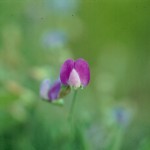Singletary Pea , Caley Pea
Lathyrus hirsutus L.
Fabaceae (Legume family)
Description
Singletary Pea is an introduced, cool season, annual legume with winged stems that grow from 10 to 40 inches or 25 to 101 cm long. Its compound leaves have two long, narrow leaflets up to 3 inches (7.6 cm) long and terminate in a branched tendril. The small, pea-like flowers are up to 0.5 inches or 1.3 cm across, with a keel and two petals. Singletary Pea blooming occurs during the spring or summer depending on the location. The petals vary from white, pink, purple, or bluish purple. Distinctive pods, 1 to 1.5 inches (2.5 to 3.8 cm) long, are covered with hair attached to small, raised bumps. Each pod contains four to ten mottled, round, and flattened seeds. Singletary Pea provides forage for livestock and wildlife. It is consumed by white-tailed deer, blister beetle, and caterpillars of certain moth species. It attracts bumblebees and long-tongued bees for pollination. Its seeds are consumed by quail and other bird species.Habitat
Historically, Singletary Pea was planted as a cover crop and a cool season forage, often mixed with small grains. It has escaped cultivation and is found in north central and northeastern Texas. Habitats include roadsides, pasturelands, thickets, savannas, and field edges. It prefers full to partial sun.Toxic Agent
The vegetation of Singletary Pea is not toxic and is highly nutritious, but the seeds contain toxic amino acids and nitrites. Lathyrism, the neurological syndrome most often produced by chronic consumption of the seeds, can affect all species, including humans, but horses are the most sensitive. Horses are usually affected by hay containing intact pods with seeds. Bovine cases usually result from grazing pastures with many mature plants. Chickens and swine are also susceptible to toxins.Signs of Livestock Ingestion
Horses with lathyrism demonstrate these signs: Incoordination of rear legs; Unusual stance with rear legs too far forward; Exaggerated stepping; Paralysis of rear legs. Cattle with lathyrism show: Reluctance to stand; Incoordination of rear legs; Inability to rise. Chronic consumption of seeds of other Lathyrus species results in skeletal deformities in growing animals. Calves born to cows that have consumed seeds of Singletary Pea for several months during gestation may have crooked legs and a curved spine.Management Strategies
Remove horses from hay containing Singletary Pea seeds as soon as signs develop; most will recover within 4 to 6 weeks. The condition becomes irreversible if the animals continue to eat the seeds. Cattle removed from the pasture recover in a few days. Pastures with Singletary Pea should be grazed before it begins blooming or seed production. Do not feed hay containing seedpods to horses.Images
Plant Characteristics
Flower Color: Pink, Purple, White
Seed Type: Bean/Pod
Duration: Annual
Stem Texture: Hairless/Smooth
Growth Habit: Forbs/Broadleaf
Leaf Shape
 : Pinnately Compound
: Pinnately Compound
Season: Cool
Distribution
 : 01 - Pineywoods, 02 - Gulf Prairies and Marshes, 03 - Post Oak Savannah, 04 - Blackland Prairies, 05 - Cross Timbers and Prairies, 07 - Edwards Plateau
: 01 - Pineywoods, 02 - Gulf Prairies and Marshes, 03 - Post Oak Savannah, 04 - Blackland Prairies, 05 - Cross Timbers and Prairies, 07 - Edwards Plateau
Distributions
Distribution refers to the ecological region in Texas that a plant has been found. You can also view a clickable map.
Book: Toxic Plants of Texas (B-6105)
Collection: Toxics, Wild Flowers
Livestock Affected: Cattle, Goats, Horses, Pigs, Poultry, Sheep
Livestock Signs: Birth Defects, Collapse, Incoordination, Paralysis, Stiffness, Unable To Rise





